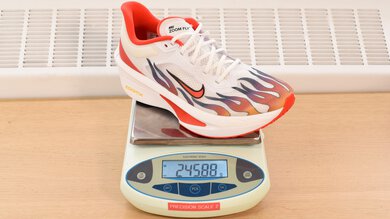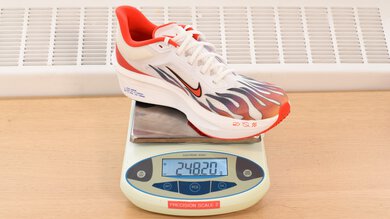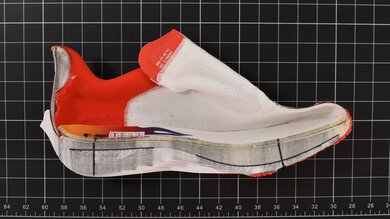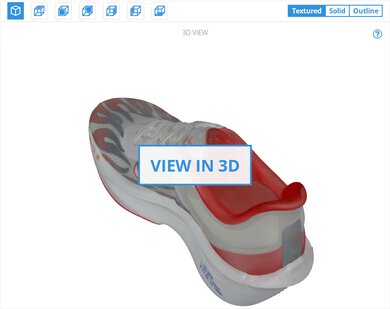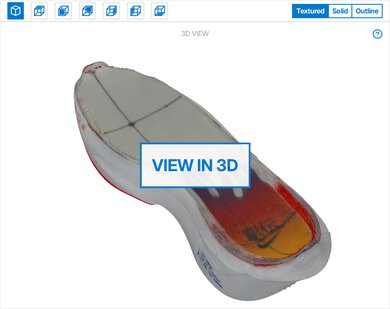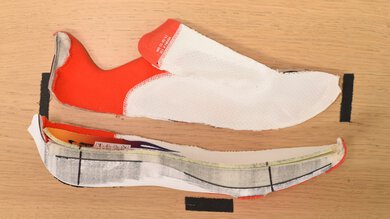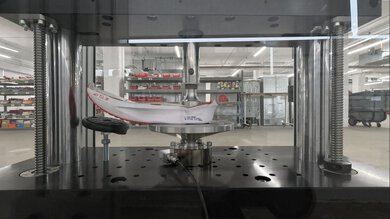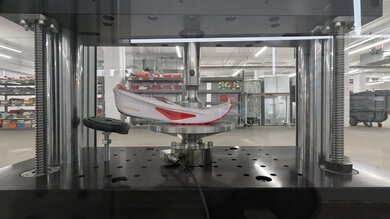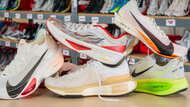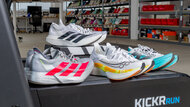The Nike Zoom Fly 6 is a carbon-plated super trainer for runners who want some race-day tech in a package built for speed training. A tall stack of foam blends a bouncy top layer of ZoomX with a durable carrier foam, all wrapped around a full-length carbon plate to add snappiness through marathon-pace workouts and uptempo runs. The result is a shoe that feels cushioned and efficient enough for your dreaded tempo sessions, yet still more durable than pure super shoes. Its extra weight and less energetic midsole mean it won't deliver the explosive pop of the Nike Alphafly 3 or Nike Vaporfly 4, and the snug fit upfront might not suit every foot, but for speed-focused miles, the Zoom Fly 6 is a dependable taste of carbon-plated shoes without the trade-offs of a carbon-plated super shoe.
Our Verdict
Although it's designed as a super trainer rather than a specialist racer, the Nike Zoom Fly 6 holds its own over the marathon. The tall, bouncy midsole and full-length carbon plate keep forward momentum ticking along, while the cushioning is good enough to dampen impacts later in the race. It won't feel as feather-light, efficient, or protective as Nike's top-tier marathon shoes, but for runners who want race-day geometry in a more training-oriented package, it delivers decent long-distance performance.
-
Decent responsiveness overall.
-
Thin and flexible carbon plate.
-
Not light enough for maximum race-day efficiency.
The Nike Zoom Fly 6 proves that a super trainer can still work when the pace heats up for shorter races. The firm forefoot and carbon plate help promote a high turnover, giving a surprisingly lively feel once you settle into tempo or threshold speed. It carries more weight than a purpose-built super shoe, and the midsole isn't as responsive, yet its quick toe-off makes it a capable option when you want race-ready turnover without stepping into dedicated carbon rockets.
-
Thin and flexible carbon plate.
-
Forefoot is firm and snappy.
-
Not light enough for maximum race-day efficiency.
The Nike Zoom Fly 6's midsole gives back a respectable pop, especially towards the front of the shoe. Push the pace, and there's enough rebound to keep turnover lively, yet the heel feels comparatively flat, so it can feel a bit more muted depending on your strike pattern. Runners who naturally load the forefoot will draw the most life from the ZoomX layer, whereas pronounced heel-strikers might miss the spring found in true premium foams.
-
Decent responsiveness overall.
-
Good bounciness towards forefoot.
-
Energy return is mediocre in the heel.
The Nike Zoom Fly 6 has good underfoot protection. The heel offers very good shock absorption for long miles, while the forefoot's cushioning feels a little less substantial yet still protective enough to partly mute the road feel. This combination keeps the ride comfortable for most types of steady efforts, though athletes who crave a plush floating sensation might wish for a bit more give upfront.
-
Very good heel cushioning.
-
The forefoot isn't the most protective.
The Nike Zoom Fly 6 has good lateral stability, thanks to a broad platform upper and a midsole compound that's on the firmer side, a welcome trait for late-run form breakdown. The firm forefoot keeps the shoe stable up front, and a gusseted tongue locks the foot in place. The tall heel stack is quite wobbly, especially for heel strikers, but for most strike patterns, the shoe stays composed overall, helping you stay efficient as fatigue sets in.
-
Thin and flexible carbon plate.
-
Gusseted tongue.
-
Wide base helps with balance.
- 7.4 Marathon Racing
- 7.8 5K/10K Racing
Performance Usages
- 7.2 Energy Return
- 7.6 Cushioning
- 7.6 Lateral Stability
Changelog
Check Price
Differences Between Sizes And Variants
We tested the Nike Zoom Fly 6 in men's US size 9, as noted on the label for our pair. The color shown here is White/Black/University Red/Habanero Red, also known as the Ekiden or Flames edition. This model is also available in other colorways, such as Bright Crimson/Lime Blast/Mint Foam/Cave Purple and White/Pure Platinum/Obsidian Mist/Gridiron. There's also a Jakob Ingebrigtsen edition in Medium Ash/Summit White/Light Silver/Metallic Gold Grain, named after the Norwegian middle-distance star. The design section applies only to the exact model we tested, but we expect other size and gender variants to perform similarly.
Compared To Other Running Shoes
The Nike Zoom Fly 6 sits in the super trainer space, between daily trainers and race-day super shoes, attempting to deliver a taste of elite-level geometry and propulsion in a more approachable training package. On paper, it offers a compelling mix: a high stack, rockered profile, and a full-length carbon plate—all inspired by the Alphafly and Vaporfly lines—but paired with a more durable SR-02 carrier foam for longevity. In practice, the Zoom Fly 6 manages to handle surging long runs, tempo efforts, and marathon-pace work fairly well, offering a rockered flow and a decent pop. For runners who want one shoe to cover the bulk of their training—and even racing in a pinch—it can be a valid choice. However, it comes with trade-offs: not nearly as efficient as full ZoomX-based race shoes like the Nike Alphafly 3, and not ideal either for easier-paced efforts like the Nike Vomero 18. Even compared to other super trainers like the adidas Adizero Boston 13, it's not as bouncy and has a less accommodating fit.
In today's market, where many runners use true super shoes for speed workouts and race simulations, the Zoom Fly 6 lands in a space that feels a bit narrow. A case can be made that most runners would benefit more in terms of performance by jumping straight into a super shoe like the Alphafly 3. That said, the added durability and less aggressive geometry make it more practical and approachable than racing shoes for those new to plated footwear or just looking to add a dedicated interval shoe to their rotation.
For more options, check out our recommendations for the best running shoes, as well as the best running shoes for men and the best running shoes for women. If you're after shoes that are specialized for all types of long runs, look towards our recommendations for the best long-distance running shoes.
The Nike Zoom Fly 6 and the Nike Alphafly 3 share visual similarities and core components, but they serve very different purposes. The Alphafly 3 is Nike's flagship marathon racer, built for maximum efficiency and propulsion with Zoom Air pods, a full ZoomX midsole, and a lighter overall weight. It’s designed to feel explosive and energetic at race pace, offering a uniquely spring-loaded forefoot that shines in long-distance racing. In contrast, the Zoom Fly 6 is a more accessible, training-focused take on that formula, featuring only a thin top layer of ZoomX over a firmer SR-02 carrier foam, resulting in a more muted and less responsive ride. It's also noticeably heavier and better suited for steady long runs or marathon-pace workouts. While the Alphafly 3 feels refined and race-ready, the Zoom Fly 6 is more durable and a safer introduction to plated shoes, especially for runners not yet ready to jump into a super shoe racer. That said, the gap in performance is significant—if you're chasing personal bests on race day, the Alphafly 3 is in a different class altogether.
The Nike Zoom Fly 6 and the Nike Vaporfly 3 both draw from the same performance playbook but serve very different roles in a runner's rotation. The Vaporfly 3 is a true racing shoe, designed to be as light, efficient, and propulsive as possible. It uses a full ZoomX midsole with an aggressive plate setup to deliver an explosive toe-off, ideal for shorter race events. It's lighter, softer underfoot, and much more energetic than the Zoom Fly 6—built purely for speed and race-day efficiency. The Zoom Fly 6, by contrast, is Nike's super trainer, a more durable and approachable alternative for interval training. While it shares some design DNA with the Vaporfly, it uses a thinner top layer of ZoomX over a firmer SR-02 foam, which dulls the responsiveness considerably. It's also heavier and doesn't offer the same bounce or snap. However, it's more forgiving, more stable, and built to last, making it a reasonable option for long runs, tempo sessions, or runners who want to get used to plated geometry without jumping into a full-on racer.
The Nike Zoom Fly 6 and the Saucony Endorphin Speed 4 are both positioned as super trainers, designed to bridge the gap between daily trainers and race-day shoes. The Zoom Fly 6 features a higher stack and full-length carbon plate, paired with a thin ZoomX top layer over firmer SR-02 foam, delivering a rockered, stable ride with good cushioning. In contrast, the Endorphin Speed 4 uses a plastic plate and PWRRUN PB foam, resulting in a ride that feels more energetic and responsive, but also firmer and less protective, especially under the heel. While both shoes can handle steady runs, up-tempo workouts, and occasional racing, the Speed 4 is lighter, bouncier, and better suited for runners who want a livelier, more grounded underfoot feel.
The adidas Adizero Boston 13 and the Nike Zoom Fly 6 are both super trainers from two of the biggest names in the game. Despite its higher stack, the Zoom Fly 6 is actually a bit lighter, delivering a plusher, softer underfoot feel thanks to a ZoomX top layer over SR-02 foam and a full-length carbon plate. It excels in steady efforts where cushioning and smooth transitions take priority. The Boston 13, by contrast, brings a firmer, more grounded ride with ENERGYRODS and a dual-foam setup that's more energetic and snappy, especially during faster paces. It also offers a more accommodating fit for those with wider feet, particularly through the midfoot and forefoot. If you're after a firmer, snappy platform, turn to the adidas. But if plush cushioning and a higher stack are what you want for your workouts, the Nike has you covered with a more forgiving, softer ride that's still bouncy.
Test Results
True to the super trainer brief, the Zoom Fly 6 lands in a middle ground: lighter than most daily trainers yet clearly heavier than pure racers. On foot, it feels trim enough to pick up the pace, but you're still aware of the extra weight compared to the Nike Alphafly 3. It's worth noting that some other super trainers, like the Saucony Endorphin Speed 4, are a bit lighter.
The fit is performance-oriented. A low-volume toe box and tapered forefoot hug the foot for a locked-in feel. That also means that wide feet or runners who enjoy generous toe splay may find it restrictive.
A full-length carbon plate sits sandwiched between two distinct foams: firmer SR-02 in the bottom and bouncier ZoomX in the top section. Because it's built with fewer layers, the plate is thinner and more flexible than the one in Nike's flagship super shoes like the Nike Alphafly 3, giving the ride a less rigid feel while still delivering that distinct plated snap when you roll onto your toes. The thin plate splits the dual-density midsole in a way that changes the ride: the heel, packed with more SR-02 foam, delivers plush landings even though the plate sits close to the foot, while the forefoot, rich in springy ZoomX, offers a noticeably livelier pop, giving the shoe two distinct personalities from back to front.
At the heel, the Nike Zoom Fly 6's energy return is unremarkable. The EVA-rich heel reliably absorbs impact, but it rebounds with limited effectiveness, making the ride feel controlled rather than springy. Heel-dominant runners looking for that bouncy sensation may want more pep.
Shift forward, and the story improves: the ZoomX top layer is present in higher quantity in this area, offering a more responsive push-off. It's not as explosive as super shoes like the Nike Alphafly 3, yet there's enough rebound to keep tempo efforts feeling efficient and to add a touch of fun to fartlek surges.
Heel underfoot protection is very good. The thicker dose of SR-02 foam absorbs pounding with ease, making runs feel forgiving even when fatigue sets in, especially for heel strikers.
The forefoot cushioning is decent in this model. There's still enough padding for most sessions, but the lower stack height also means the midsole doesn't absorb quite as much force from impacts as the heel. Runners who land on their forefoot will notice it most, especially when they dial up the pace and apply more force.
The heel isn't very soft, but it's not super firm either. This balance means it's stiff enough to maintain stability despite the tall platform (without feeling brick-hard either), helping to provide a reasonably forgiving feel.
The forefoot is decidedly rigid. That extra firmness creates a reliable lever for toe-off, but it also means the ride can feel a bit unforgiving upfront if you're cruising rather than pushing the pace. Runners who like a firm, snappy platform up front will enjoy the sensation; those who prefer a softer forefoot might find it a bit unrelenting.
Check Price
Comments
Nike Zoom Fly 6: Main Discussion
Let us know why you want us to review the product here, or encourage others to vote for this product.
The full review has been posted here. Let us know what you think!


